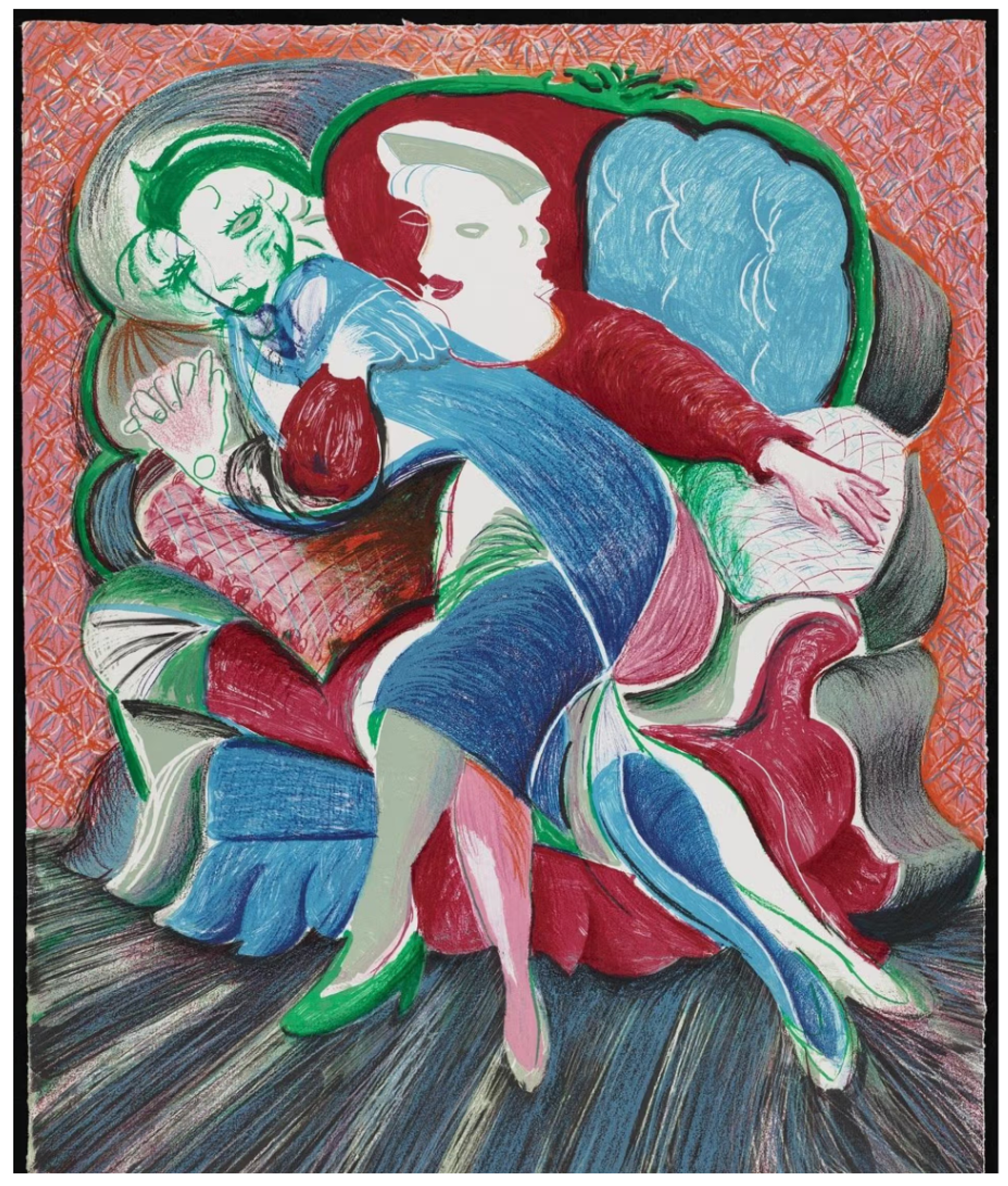Market Watch: Why Day Sales, Editions, and Experience Still Matter

 Pretty Tulips © David Hockney 1969
Pretty Tulips © David Hockney 1969Market Reports
Another June auction season has come and gone - and while it may not have delivered blockbusters, it did deliver insight. Quiet headlines masked a reshuffled calendar, steady day sale performance, and deeper signals about how the market is evolving for both collectors and institutions alike. As always, the story isn’t just in the totals - it’s in the structure.
A Familiar Format, But a Fading Mood
While not dramatically restructured, this year’s June auction week still felt notably subdued. Christie’s continued its decision to forgo a marquee evening sale, sticking with a Post-War to Present Day Sale instead. Phillips followed the same format as last year, combining its Modern & Contemporary Evening and Day Sales into a single session. Sotheby’s kept its typical structure, with Modern and Contemporary evening and day sales - but even then, the energy felt muted.
Sotheby’s evening sale underperformed compared to last year, and while there were strong results for Nudes by Tamara de Lempicka and Jenny Saville - the mood felt hesitant. Whether it’s macro pressures, cautious consignors, or the same well-worn narratives we’re all a little tired of revisiting, there was (again) a quiet haze over what used to be a reliably high-stakes point in the calendar.
That’s not to say the auction houses are to blame. They remain central to the art market - core institutions staffed by specialists whose expertise and enthusiasm have shaped the field for decades. But the reality is that the market is shifting - and not just the market, but the conversation around it. During the dot-com boom or the hyperactive post-pandemic years of 2019–2020, auctions were the go-to. Collectors trusted the model; few were willing to gamble elsewhere.
Now, the landscape is more fragmented. Online sales are standard, algorithmic tools shape valuations, and conversations happen faster, more publicly, and in more places. I’m not suggesting that these developments are replacing the traditional auction model - but they are reshaping it. So when marquee auctions feel subdued, it’s worth remembering: much of the activity, energy, and liquidity is happening elsewhere - in private sales, on digital platforms, and through alternative infrastructures that weren’t even part of the picture five years ago.
Why the Day Sales Deserve More Attention
As I’ve said before, the real auction action - and arguably the most reliable insights - lie in the day sales. If you’re still sleeping on these, you’re missing where much of the liquidity is happening.
Two standout results came from David Hockney’s Arrival of Spring prints:
– At Sotheby’s Contemporary Day Sale 31st of May, No.1 sold for £406,400
– At Christie’s Post-War to Present 4th of May achieved £504,000 - tying the current auction record, for a different edition of this same variation, first set at Phillips in 2022.
These two prints now stand as the highest-valued individual editions in Hockney’s entire market. Both are large-scale editions of just 10, and while the public results are impressive, private market demand is even more intense - I can confirm that firsthand. Demand is outpacing supply. These editions are tightly held and carefully placed by Hockney’s gallery representatives into the hands of serious collectors. Getting your hands on one of these works on the public market is tough. And it’s not just about the works themselves; it’s about what they represent. Editions like these offer collectors a combination of familiarity, visibility, and strategic pricing - no longer seen as entry points, but as smart acquisitions in their own right.
Just weeks earlier, at Art Basel, Mid November Tunnel sold through Annely Juda Fine Art for $13–17 million (USD) - a sharp reminder that Hockney’s market remains strong across both editions and originals. Explore the latest insights in the David Hockney Seller's Guide.
Meanwhile, Phillips posted a strong result for Jean-Michel Basquiat’s MP (1984), which hammered at £4 million - pushing the sale 2% above its high presale estimate, and only 2% shy of last year's hammer, despite offering fewer lots. That’s notable: the 2024 equivalent came in 15% below estimate, suggesting there’s now a sharper focus on getting pricing right.
A Strong Month for Prints - In London and New York
It wasn’t just the day sales making headlines - the editions market flexed its strength this month. Both Phillips and Bonhams set new auction records for key works from Warhol’s Endangered Species series, with standout results for African Elephant, Orangutan, Bald Eagle, and Grevy’s Zebra. For a full breakdown of these sales, see our latest auction report - and explore our Warhol Seller’s Guide for the most up-to-date insights on his current market and print values.
 Art Basel 2025 © Courtesy of Art Basel
Art Basel 2025 © Courtesy of Art Basel Why Experience - Not Just Sales - Is Driving the Art Market in 2025
From the reports I read - and for the first time in a while - Art Basel actually seemed to reflect the true sentiment of the market. Yes, dealers still touted big sales (as they do), but this year’s energy felt more believable. Last year, the prevailing mood was attributed to “doom porn”; this time, it felt livelier.
Kenny Schachter captured this shift well during The Baer Faxt Live at Basel, opening his segment with a line that punched:
“If I read one more article about ‘the end of the art market’… I’m going to puke.”
Blunt as ever, he pushed back on the tired cynicism - rejecting the idea that people no longer love art or that “experiences” are somehow replacing collecting. And to his credit, he’s not wrong. People do still love art. But I’d argue the experience isn’t separate from the act of viewing or collecting - it is the act itself. Fairs, galleries, even collectible drops aren’t just about transactions; they’re the environments where meaning is formed. They’re where connection happens. And that’s the message we need to be doubling down on.
 Image © Kasing Lung, special edition Labubu doll for Art Basel, 2025 © Courtesy of Art Basel
Image © Kasing Lung, special edition Labubu doll for Art Basel, 2025 © Courtesy of Art BaselThe Blue Labubu Drop: What Basel’s Most Viral Moment Reveals About New Collectors
One moment in particular though, captured where the art market is really at - away from auction houses and legacy structures.
A small blue Labubu figurine, holding a spirit level in tribute to art installers, might have looked like a sideshow - but it wasn’t. Released in two on-site drops, priced at CHF 200 (around $250), all 100 editions sold out immediately. According to The Art Newspaper’s Carlie Porterfield, someone was offering $5,000 in cash for one just minutes later.
It’s tempting to write this off as a gimmick, but that would miss the point. These drops speak directly to how the next generation of how collectors operates. For them, collecting isn’t just about ownership - it’s about participating in a moment. Scarcity, cultural cues, virality, and resale potential are all part of the value system. This is a generation shaped by streetwear, NFTs, and digital-native brands. They’re not buying into tradition; they’re buying into a network - one built on shared moments, visibility, and cultural context.
Of course, this isn’t new. The art world has always traded in - and carefully marketed - exclusive experiences. Think of Larry Gagosian’s private one-night dinner exhibition perched above the cliffs of Capri, where top-tier collectors and artists gathered at Casa Malaparte. It sounds cinematic because it is! These aren’t just social moments, they’re carefully choreographed settings that shape how art is experienced, remembered, and valued. They’re not just about exclusivity - they’re about atmosphere, context, and emotional imprint.
But experiences are, by nature, impermanent. They shift with cultural tides, economic realities, and generational expectations. The mistake isn’t in acknowledging the value of experience - it’s in assuming it looks the same today as it did even five years ago. And right now, the experiences that matter are often informal, digital, drop-driven, or community-based. That’s what we should be paying attention to - because that’s where the next generation of collectors is forming its habits.
You Know I’m Going to Relate This to the Blue Chip Editions Market - So Here It Goes
Now hear me out - I’m not just calling this for effect, because it really does track. This shift is clearly reflected in the editions market. Blue chip prints by artists like Hockney, Warhol, and Haring now sit right at the intersection of art, culture, and identity. They’re priced within reach (relatively), instantly recognisable, and carry the same semiotic weight as coveted merchandise - they say something about who you are, what you value, and what you’re part of.
But, they also offer something else: a system. A structure that’s visible, trackable, and, in many ways, gamified. For many next-gen collectors, editions function almost like the stock market - familiar, strategic, and data-driven. You can monitor values, time the market, compare performance, and make decisions that feel as tactical as they are personal.
That’s why online trading floors matter more than ever. They don’t just offer price transparency - they enable participation. They flatten access, encourage fluid movement between buyer types, and give users the tools to treat collecting as both passion and portfolio. This same logic played out in the frenzy over Labubu at Basel: limited supply, insider access, and rapid resale potential - the kind of mechanics that resonate with a collector base shaped by hype drops and real-time tracking tools.
Whether you see that as exciting or uneasy, it’s already reshaping the market. The real challenge now isn’t just tracking sales - it’s understanding what gives them meaning. Because if collecting is going to remain relevant, it has to feel dynamic, visible, and alive - not just to institutions and insiders, but to the networks building the next version of the art market in real time.
What This All Means for the Market Ahead
June didn’t deliver spectacle - but it delivered clarity. Day sales are where pricing intelligence is most visible, the editions market is behaving more like a structured asset class, and collector engagement is increasingly driven by context and experience, not just object quality. These aren’t peripheral shifts - they point to a broader redefinition of where value sits, how it’s signalled, and who gets to participate. As we head into the quieter summer stretch, it’s worth watching not just who’s buying - but how and why.







